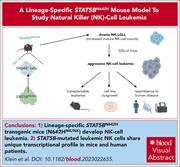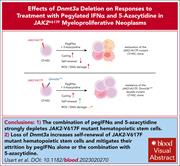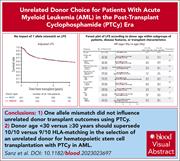Issue Archive
Table of Contents
BLOOD COMMENTARIES
REVIEW ARTICLE
Evidence for antigen presentation by human neutrophils
Neutrophils are important mediators of inflammation and play an increasingly accepted role in altering immune responses. This excellent review by Moffatt and Gwyer Findlay summarizes the current knowledge on T-cell–neutrophil interactions in tissues and lymph nodes. The authors highlight discrepancies between mice and humans and identify key areas where more research is needed to understand the importance of antigen presentation by neutrophils in humans.
CLINICAL TRIALS AND OBSERVATIONS
Axicabtagene ciloleucel vs standard of care in second-line large B-cell lymphoma: outcomes by metabolic tumor volume
Clinical Trials & Observations
The ZUMA-7 trial demonstrated superiority of the CD19-directed chimeric antigen receptor T-cell therapy axicabtagene ciloleucel (axi-cel) over prior standard-of-care (SOC) chemotherapy with autologous stem cell transplant for second-line treatment of early relapse or refractory large B-cell lymphoma. Locke et al analyzed outcomes of patients in this trial by metabolic tumor volume (MTV), showing that MTV was prognostic of responses in both arms and that axi-cel was superior to prior SOC in patients with either high or low MTV. These data help risk stratify patients prospectively for both efficacy and chance of experiencing neurotoxicity or cytokine release syndrome.
LYMPHOID NEOPLASIA
A lineage-specific STAT5BN642H mouse model to study NK-cell leukemia
MYELOID NEOPLASIA
Loss of Dnmt3a increases self-renewal and resistance to pegIFN-α in JAK2-V617F–positive myeloproliferative neoplasms
Interferon alfa (IFN-α) can induce deep molecular remissions in some patients with the myeloproliferative neoplasms (MPNs) polycythemia vera and essential thrombocythemia harboring JAK2-V617F, but resistance can emerge. Usart et al report compelling evidence from mouse models and human cells that heterozygous and homozygous deletion of Dnmt3a prevents the hematopoietic stem cell exhaustion observed with IFN-α treatment of JAK2-V617F MPNs. Loss-of-function DNMT3a mutations allow increased self-renewal of JAK2-V617F stem cells, explaining the resistance to IFN-α therapy in MPN patients with DNMT3A-mutated disease.
PLATELETS AND THROMBOPOIESIS
Wiskott-Aldrich syndrome: a study of 577 patients defines the genotype as a biomarker for disease severity and survival
Clinical Trials & Observations
Wiskott-Aldrich syndrome (WAS) is an X-linked monogenic inborn error of immunity characterized by thrombocytopenia, eczema, recurrent infections, autoimmunity, and cancer risk. In a tour de force, Vallée and colleagues describe the genetic landscape affecting the WAS gene across 577 patients and resolve the associations between specific gain- or loss-of-function mutations and the severity of clinical phenotype. Class I mutations portended less severe disease while class II mutations predicted earlier onset and more severe disease with worse survival, allowing personalized prognostic advice and informing tailored care.
TRANSFUSION MEDICINE
Genetic regulation of carnitine metabolism controls lipid damage repair and aging RBC hemolysis in vivo and in vitro
Nemkov et al used an interdisciplinary approach incorporating omics analyses, animal models, and genome-wide association studies to probe the genetic factors that influence cellular metabolism during red blood cell (RBC) aging. The authors identified L-carnitine metabolism as the most reproducible pathway involved across multiple blood donations and highlighted a link between this pathway, ex vivo aging of RBCs during storage, in vivo aging of RBCs in circulation, genetic polymorphisms, and clinical impact after transfusion. Their work suggests a potential new strategy to improve red cell storage quality.
TRANSPLANTATION
Younger unrelated donors may be preferable over HLA match in the PTCy era: a study from the ALWP of the EBMT
Clinical Trials & Observations
In selecting individual allogeneic transplantation plans for patients, considerations about graft-versus-host disease (GVHD) prophylaxis and donor choice interact. With increasing use of posttransplant cyclophosphamide (PTCy) as GVHD prophylaxis, Sanz et al retrospectively analyzed data from patients with acute myeloid leukemia in remission who underwent allograft from unrelated donors and show that among PTCy-treated patients, donor age, not HLA disparity, was the most important predictor for survival after transplantation. These findings will help refine our approaches in selecting the right type of GVHD prophylaxis and optimal donor for patients.
VASCULAR BIOLOGY
An oral carbon monoxide–releasing molecule protects against acute hyperhemolysis in sickle cell disease
Hyperhemolysis is a life-threatening complication of sickle cell disease (SCD). Nguyen and colleagues utilized in vitro and in vivo models of hyperhemolysis to demonstrate that microparticles from red blood cells lead to the same type of endothelial injury observed in other severe complications of SCD. The authors reveal the novel ability of carbon monoxide–releasing molecule CORM-401 to reduce hemolysis-induced endothelial injury and organ damage, providing a possible future treatment strategy for hyperhemolysis-associated SCD complications.
BLOOD WORK
-
Cover Image
Cover Image
![issue cover]()
Immunofluorescence staining of TNFα-treated human umbilical vein endothelial cells under flow conditions to evaluate activation and apoptosis markers: PECAM-1 Alexa Fluor (AF) 647 (red), ICAM-1 PE (orange), VCAM-1 AF 488 (green), Hoechst 34442 (blue), and annexin-V AF 594 (purple). See the article by Nguyen et al on page 2544.
- PDF Icon Front MatterFront Matter
- PDF Icon Table of ContentsTable of Contents
- PDF Icon Editorial BoardEditorial Board
Advertisement intended for health care professionals
Email alerts
Advertisement intended for health care professionals










